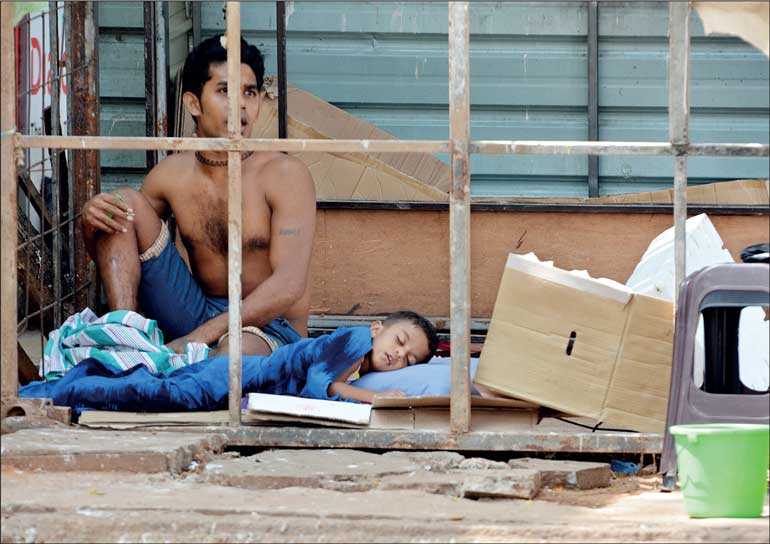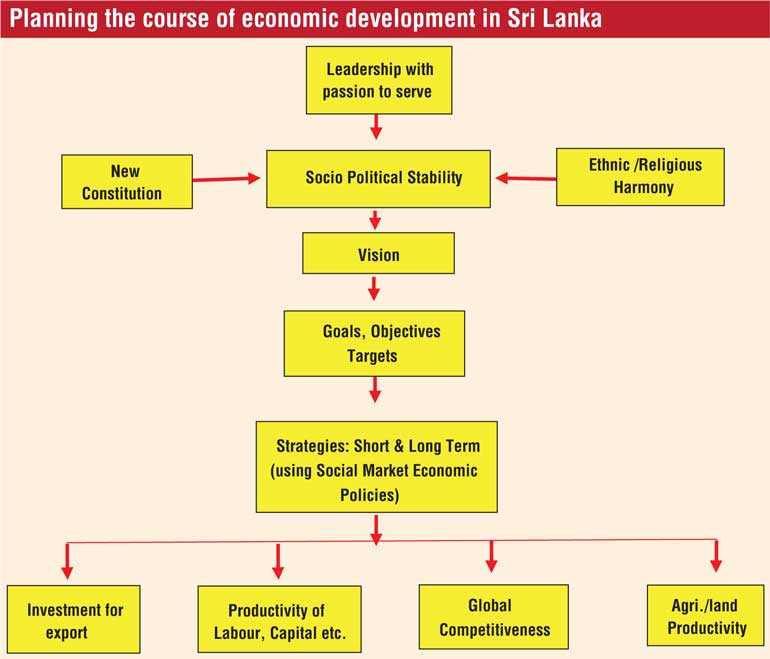Tuesday Apr 08, 2025
Tuesday Apr 08, 2025
Wednesday, 31 July 2019 00:00 - - {{hitsCtrl.values.hits}}


urrently Sri Lanka appears to be moving towards a failed state status like that of Afghanistan, Somalia and South Sudan. This article discusses why this has happened and gives an indication of what has to be done to avoid such  a situation and move towards prosperity.
a situation and move towards prosperity.
Failed state
What is a failed state? ‘It is a country whose government has failed to carry out its basic responsibilities such as providing good governance, security and public services such as education and health. Therefore failed states are increasingly trapped in a cycle of poverty and violence.’ Sri Lanka is indeed already trapped in a cycle of poverty and violence.
Sri Lanka poor by global standards
According to the World Bank, the number of those earning less than $ 2.5 per day was about 32% (in inflation adjusted terms) of the people as of 2012/13 (Sri Lanka: A Systematic Country Diagnostic, World Bank, 2016) with extreme poverty mainly in the estates and in the northern and eastern parts of the country. This level of poverty may have now increased due to the recent rise in prices of essentials.
In 1970 Sri Lanka’s per capita income was $ 225 and that of Singapore was $ 925. By 2017 Sri Lanka’s per capita income had grown only to $ 4,074. However, Singapore’s per capita income had zoomed to $ 57,714 by 2017! (IMF data) mainly on account of heavy Foreign Direct Investment inflows, excellent leadership and good governance. This shows how poor Sri Lankan people are at present by global standards.
Failure to attract FDI
This situation is mainly due to the failure on the part of Sri Lanka to attract sufficient Foreign Direct Investments (FDI) which is essential since national savings are low (25% of GDP in 2018) and the local firms do not possess the necessary technologies to add value to goods and services and have poor access to global markets.
By 2016 Sri Lanka had received a stock of only $ 9.7 billion in FDI (most of it used for construction and not manufacturing); while Singapore had received a massive FDI stock of $ 1.1 trillion; Hong Kong also had received a stock of over $ 1 trillion and most of the other small East Asian economies had received more than $ 100 billion in FDI (UNCTAD, 2017).
Reasons for economic stagnation
The main reasons why Sri Lanka has stagnated in this manner are the fact that FDI had been avoiding this country due to,
i. the political instability that emerged after 1956 on account of a) Sinhala Buddhist extremism that led to the 30 year LTTE war, the attacks against Muslim businesses and homes at Aluthgama, Digana, Teldeniya, Ampara, etc. and b) the abject failure of governments and leaders since 1956 to find a solution to this problem.
ii. the inability on the part of leaders as well as the media to explain to the people that export oriented investment is essential for an economic take off (some of these two parties refer to foreign investments as ‘selling’ SL’s assets to foreigners as if they can be dumped into a bag and taken away, when this is what the successful economies of the world including China (a former failed state) have been resorting to as a major development strategy all along.
iii. the policy inconsistency of governments vacillating between import substitution/protection for local businesses (which has failed) and open market economic policies; the objective of the latter was production for export since Sri Lanka is a small country that cannot produce everything it needs locally and by doing so is unable to earn the foreign exchange required to pay for its imports.
It should be noted that history keeps on repeating itself as exemplified by the Easter Sunday attacks unleashed by the terrorists led by Zahran most probably as a reprisal against earlier attacks on Muslims. History repeated itself again after the Easter Sunday massacre as shown by another wave of harassment of innocent Muslims and their business establishments. This type of violence will go on until a genuine effort is made to stop it.
It is strange that Sinhala Buddhist extremists have been behind this series of attacks against the minority communities in SL aided and abetted by our power hungry/corrupt politicians when the Buddha had admonished the cultivation of metta/maithree (loving kindness), karuna (compassion), muditha (sympathetic joy), and upekkha (balance of heart/mind; empathy; opposite of hostility) by his followers.
It is obvious that if they had accepted the great teacher’s advice and if our governments had succeeded in providing good governance while adopting social market economic policies (mix of socialism and capitalism), Sri Lanka today would be among the prosperous nations of Asia such a Singapore and South Korea.
The question that arises then is why these extremists did not follow the Buddha’s advice. Probably they think that Sinhalese (70% of the population) would be better off if this course of harassment of minority communities is undertaken; they may perhaps think that it is as heroic as the Sinhala prince Dutugemunu’s campaign against Elara the South Indian Chola prince who was ruling the north and the subsequent unification of the country in 161 BC, i.e. 2,180 years ago.
Sri Lanka reduced to a state of collapse
But the above mentioned facts and figures especially that of our per capita income which was a low of about $ 4,000 in 2017when that of Singapore had increased spectacularly to $ 58,000, due to a huge inflow of FDI of over $ 1 trillion compared to SL’s paltry FDI stock of $9.7 billion by 2016, clearly prove otherwise, (as the latter has deliberately cultivated communal harmony, good governance and social market economic policies; see below).
This is not all; according to reports, professionals and skilled persons had begun to leave the country in thousands after 1956 as they could not tolerate the worsening situation here – according to reports three million such people had left the country up to date. On top of that by 2018 Sri Lanka’s external debt had risen to $ 52 billion (CBSL); the country has therefore been compelled to beg or borrow; in fact it is borrowing more dollars to repay this debt as exports and foreign exchange earnings have not expanded significantly leading to a collapse of the economy!
These extremists in other words have not been as heroic as they thought themselves to be; they have driven the entire nation including the Sinhala community to be one of the poorer nations in the world besides reducing it to being a failing state.
Social harmony in Singapore
The Government of Singapore led by its great leader Lee Kwan Yew on the other hand took deliberate constructive action especially to enshrine multi-culturism, secularism and meritocracy in the 1965 Constitution to bring about social harmony and integrate the Chinese, Malay Muslim, Indian and other communities into a single integrated nation after the Chinese-Malay clashes of July 1964; secularism (meaning religion should not be part of the affairs of state) was actually intended to protect religious freedom so long as it does not clash with public order.
This was buttressed by,
a) the National Pledge of 1966 which introduced English as the common language of the nation,
b) the Presidential Council for Minority Rights in 1970 to prevent discrimination against any race or religion,
c) the Ethnic Integration Policy of 1989 for Housing to ensure a certain proportion of housing units in an apartment block is set apart for ownership by persons belonging to the various ethnic/religious groups so that they are sort of compelled to share common facilities leading to building of trust and friendships,
d) the Maintenance of Religious Harmony Act of 1990 which introduced legal measures to combat threats to social harmony and introduced a national military service for males,
e) the Community Centres with facilities for common activities in urban areas in 1990,
f) the Racial Confidence Circles composed of leaders from the various communities in every constituency in 2002 and
g) the Community Engagement Program 2006 to create trust, understanding and cooperation among the various ethnic and religious groups. It may be noticed that all these are positive/constructive measures to bring about social harmony and not necessarily for preventing terrorism only. It should also be mentioned that these may have resulted in a strong foundation of communal harmony which created the political stability required for the well-known economic take-off in Singapore.
The preliminaries and goals of the strategies
So what needs to be done to overcome the present crisis situation in Sri Lanka? Firstly the people of Sri Lanka have to find a leader who is honest and is devoted to serve the needs of the people, as all leaders have failed to deliver up to now.
The first task for him/her is to bring about socio- political stability mainly by formulating a new constitution on the lines of that of the USA or South Africa due to the fact that the present one is extremely defective and by introducing other institutional arrangements like those of Singapore for creating harmony among the various communities, since inter-communal clashes after 1956 have discouraged investments.
Then the selected leader has to announce a vision, for example, of alleviating poverty along with equality of incomes. The goals, objectives and targets have to be mentioned next. The 17 Sustainable Development Goals of the UN including the alleviation of poverty and zero hunger could be cited.
Long-term and short-term strategies to realise the goals have to be proposed next; short term strategies should be formulated and implemented to serve the basic needs of the people such as provision of clean drinking water, irrigation, paved roads, quality planting material, warehousing for perishables, marketing of agricultural produce for farmers, uncontaminated food for consumption, quality water and power supplies, public transport, health and education services to the public, etc. The provision of these can win the trust of the people for a ruling political party.
The long-term strategies (with social market economic policies – mix of socialism and capitalism) to achieve the goals are:
1. Increasing export oriented investments rapidly.
2. Raising the level of productivity of all sectors.
3. Enhancing the global competitiveness of all products and services.
4. Introducing land reform to raise the level of rural agricultural productivity and of incomes.
Planning the course of economic development in Sri Lanka
What should follow are implementable sub strategies and actions under each main strategy as not much has been achieved by all governments in removing various constraints to progress .These will not be repeated here as they were included in my article published in the Daily FT on 26 February.
Lastly, two more strategies that have to be proposed are:
1. The leader/s, along with professionals and the clergy to explain these strategies to the people in a language they understand to create a consensus.
2. The people supported by the intellectuals and the clergy to continue to pressurise the political leaders, once they come to power, to implement these strategies speedily and efficiently for realisation of the goals.
Conclusion
It is clear now that the efforts of Sri Lankan leaders to appeal especially to Sinhala Buddhists voters to win elections and their failure to promote harmony among the various ethnic and religious communities have led the country to economic disaster and poverty of all people (mostly of Sinhala Buddhists since they are the majority community).
So the national leaders , business leaders and others concerned including the Buddhist clergy have to grab (perhaps the last) opportunity presented by the forthcoming Presidential and General Elections to create a leadership that is passionate about serving the needs of the people.
This leadership has to firmly promise that they will take all the measures to bring about harmony among the different ethnic and religious groups in the country to arrive at political and social stability to enable the attraction of export-oriented investments while adopting the economic development strategies such as those mentioned above required to overcome the collapse of the economy and extreme poverty.
In other words the political leaders and others must realise ‘it may be true that morality cannot be legislated, but behaviour can be regulated. The law may not change the heart, but it can restrain the heartless’ (Martin Luther King)
(The writer is a development economist.)